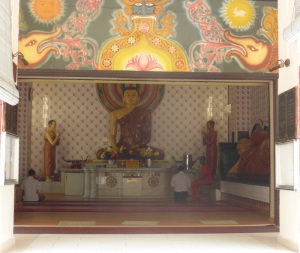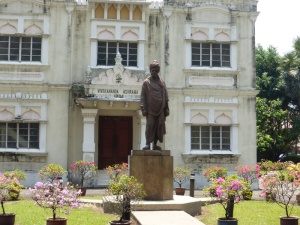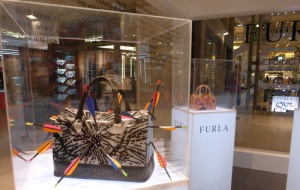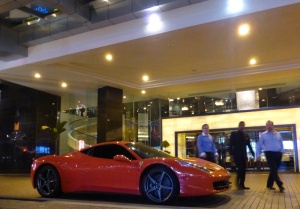Kuala Lumpur, Malaysia = Diversity

Feeling as though we were visiting India, China, and a big modern Asian city all in one, Barry and I recently flew to Kuala Lumpur (KL), so we could renew our tourist visas for Bali. We love the variety and energy of this Malaysian capital. A city of many peoples and religions, Kuala Lumpur has beautiful mosques, many Christian Methodist and Lutheran churches and schools, Chinese temples, Buddhist monasteries, ashrams, Hindu temples, and more.
Mosques – some big, some small – are scattered throughout the city. Islam is the national Malaysian religion, but the city accommodates other religions too. 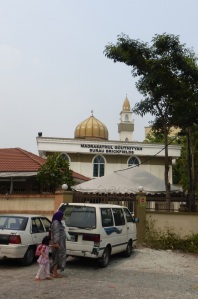 Streets pulsate with life and variety. Stalls along Petaling Street, Kuala Lumpur’s Chinatown, sell almost everything.
Streets pulsate with life and variety. Stalls along Petaling Street, Kuala Lumpur’s Chinatown, sell almost everything. 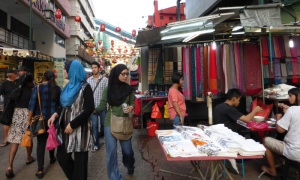 As in Lin’an, Shanghai, and other Chinese cities, the KL Chinatown market offers much variety – including roasted chestnuts – see the bin on the right.
As in Lin’an, Shanghai, and other Chinese cities, the KL Chinatown market offers much variety – including roasted chestnuts – see the bin on the right. 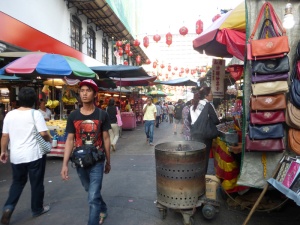 Bargains are to be had in the KL Chinatown.
Bargains are to be had in the KL Chinatown.
Tall turbaned Sikhs, Muslim women, with their scarves, smiling uniformed school children, sari clad women, dark Africans, young Chinese tourists, and Western business people in suits all mix on the KL streets and in the markets.
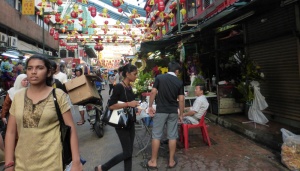 We also loved KL’s “Little India,” especial the tasty (and cheap) food we could find there.
We also loved KL’s “Little India,” especial the tasty (and cheap) food we could find there. 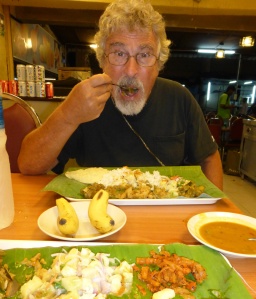 This delicious dinner included two Indian thali plates, a big bottle of water, and bananas for dessert; the cost = $4.00 for two. 🙂
This delicious dinner included two Indian thali plates, a big bottle of water, and bananas for dessert; the cost = $4.00 for two. 🙂
The Chapatti House, a favorite, was near our Hotel Sentral, nice and conveniently located in “Little India, it serves buffet breakfasts on the rooftop. We ate well.
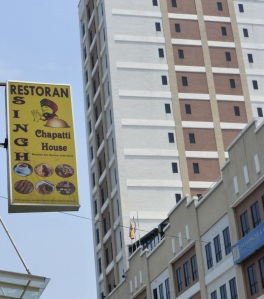 “Little India” also had beautiful saris, gold jewelry, and fragrant spices for sale.
“Little India” also had beautiful saris, gold jewelry, and fragrant spices for sale. 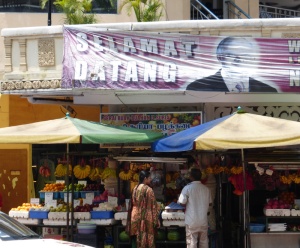 Modern buildings of interesting designs line some streets.
Modern buildings of interesting designs line some streets. 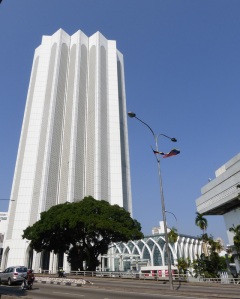 Malaysians line up in a proper queue as they wait for the monorail – most text as they wait. 🙂
Malaysians line up in a proper queue as they wait for the monorail – most text as they wait. 🙂 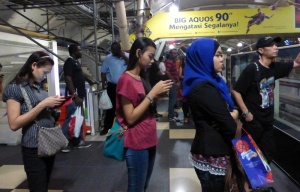 KL is modern in many ways: the water from the tap is safe to drink; the toilets can take tissue; the stop lights have ticking noises and ribbed center tiles on the sidewalks, so the blind can cross the streets safely; the one-way roads are respected—you don’t have to look behind you to cross a street. The city emphasizes education with many schools and universities, medical centers, and health clubs.
KL is modern in many ways: the water from the tap is safe to drink; the toilets can take tissue; the stop lights have ticking noises and ribbed center tiles on the sidewalks, so the blind can cross the streets safely; the one-way roads are respected—you don’t have to look behind you to cross a street. The city emphasizes education with many schools and universities, medical centers, and health clubs.
Highlights of our intense few days as tourists include:
– A night in the Bukit Bintang area of bright lights, modern high-end shops and restaurants. I felt as though were in a Shanghai high-rise modern mall with its Cartier watches, Louis Vuitton luggage, $500.00 (U.S.) Furla handbags, and other expensive brands.
A memorable Furla handbag on display –
Barry with his smoothie, a young conservative Muslim couple, and hip youth amble along the Bukit Bintang streets.
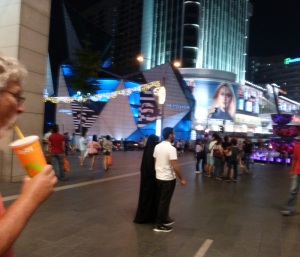 In this modern city, we occasionally saw a woman in a burqa, a full-body cloak worn in some Muslim traditions. The young woman above (we could tell by the way she walked) was completely enclosed in black except for the thin strip for her eyes. The KL temperatures in March when we were there range from 82-93 degrees F (28-34 degrees C) although it felt much hotter since the humidity is around 84%! How could she keep from fainting?
In this modern city, we occasionally saw a woman in a burqa, a full-body cloak worn in some Muslim traditions. The young woman above (we could tell by the way she walked) was completely enclosed in black except for the thin strip for her eyes. The KL temperatures in March when we were there range from 82-93 degrees F (28-34 degrees C) although it felt much hotter since the humidity is around 84%! How could she keep from fainting?
We did see a “Ladies Only” car on a train, but on the monorail and other places men and women seem to mingle freely.
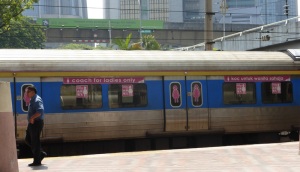 “Coach for ladies only” in the KL train station.
“Coach for ladies only” in the KL train station.
A recent New Yorker article report from Saudi Arabia tells about women now being allowed to work in some shops there. These women must wear the full-body cloak, but most, although they don’t have to, choose also to wear the niqab, the face cloth that covers all but the eyes: “Various sales women told me that they wear it to protect themselves from harassment” (Zoepf, K. “Shopgirls” p. 63, 12/23 & 30/13). I was told that the “Ladies Only” car is a preference for some women traveling without a man in Malaysia; it’s not mandatory.
At the top floors of the KL mall, as in China, we could choose from Japanese seafood and noodles, Korean BBQ, Western steaks, Vietnamese pho, or fresh juiced wheat grass and mango smoothies.
High-end goods fill the mall.
–
Another highlight, found in the The Lake Garden area that includes the largest enclosed aviary, “best in the world” butterfly park, and National Mosque, is the Museum of Islamic Arts. It has the largest and finest collection of Indian, Chinese, Malay, and SE Asia Muslim calligraphy, textiles, jewelry, silver, and paintings. We spent much of one day there. Religion permeates much of what we saw.
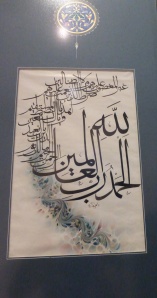 This calligraphy piece by artist Gholamreza Rahpeyma (born 1959) honors the “Holy Qur’an, the Names of Allah and Prophet Muhammad.” Chinese Islamic art is represented too.
This calligraphy piece by artist Gholamreza Rahpeyma (born 1959) honors the “Holy Qur’an, the Names of Allah and Prophet Muhammad.” Chinese Islamic art is represented too. 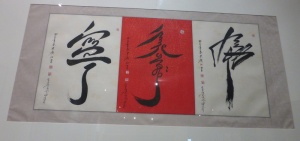 Of his piece, Haji Noor Deen Mi Guang Jiang (born 1963) says, “As a Chinese Muslim calligrapher, I have a deep sense of responsibility in promoting, propagating and carrying forward this intricate art form and precious cultural heritage.”
Of his piece, Haji Noor Deen Mi Guang Jiang (born 1963) says, “As a Chinese Muslim calligrapher, I have a deep sense of responsibility in promoting, propagating and carrying forward this intricate art form and precious cultural heritage.”
A few women had pieces in this notable Islamic Arts Museum. Magic Carpet #3 is such an example by a Muslim woman. 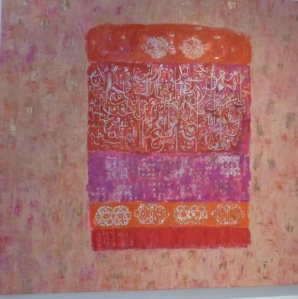 The painter, Ola Hejaziow, now lives in Jeddah, Saudi Arabia. She says, “The inspiration for my work comes from many years of travelling over the world, everyday life, and from some of my favourite artists.”
The painter, Ola Hejaziow, now lives in Jeddah, Saudi Arabia. She says, “The inspiration for my work comes from many years of travelling over the world, everyday life, and from some of my favourite artists.”
Another section of the museum features illustrated Qur’ans. 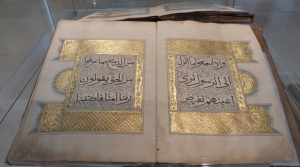 Written during the Qing Dynasty, this Chinese Qur’an above is decorated with Chinese motifs such as cloud bands and peonies.
Written during the Qing Dynasty, this Chinese Qur’an above is decorated with Chinese motifs such as cloud bands and peonies.
Among many other examples of beautifully illustrated Qur’ans is the Dala’il al-Khayrat. The museum describes it as the most celebrated prayer book. Written by Muhammad Ibn Sulayman al-Jazuli (d. 1465 AD/869 AH in Morocco), it has been copied throughout the Islamic world from North Africa to the Malay Archipelago, Turkey, and China. While most Islamic prayer books have illustrations of the holy mosques of Mecca and Medina, this copy illustrates the minbar (a pulpit) and tombs of the Prophet and his companion. 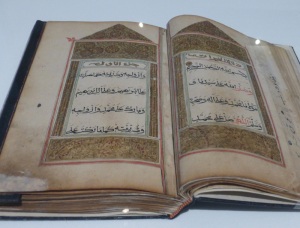 A guilded leaf reveals beautiful intricacy.
A guilded leaf reveals beautiful intricacy. 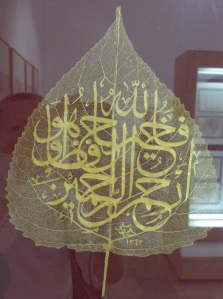 Such guilded and pierced leaves reached the peak of their popularity during the 19th century AD in Ottoman Turkey. To create this piece, “the leaf was completely dried and flaked leaving only the web of vein-like, skeletal membrane of the leaf to support the calligraphic composition. . . . ‘He is the most Merciful of the Merciful,'” says the script. The museum also includes other wonderful exhibits. When you go to KL, be sure to visit The Museum of Islamic Arts.
Such guilded and pierced leaves reached the peak of their popularity during the 19th century AD in Ottoman Turkey. To create this piece, “the leaf was completely dried and flaked leaving only the web of vein-like, skeletal membrane of the leaf to support the calligraphic composition. . . . ‘He is the most Merciful of the Merciful,'” says the script. The museum also includes other wonderful exhibits. When you go to KL, be sure to visit The Museum of Islamic Arts.
– Another good stop is The National Textile Museum in a marvelous heritage building. 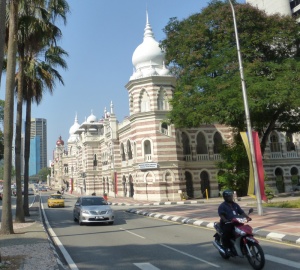 Inside, dioramas depict various textiles and how to make them.
Inside, dioramas depict various textiles and how to make them. 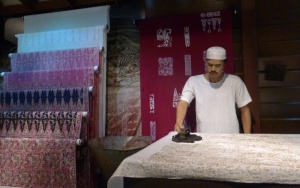 – Throughout the city, the many buildings under construction contrast with the old KL shops:
– Throughout the city, the many buildings under construction contrast with the old KL shops: 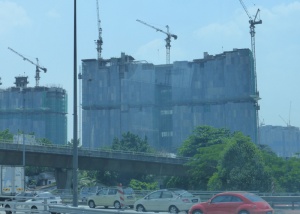
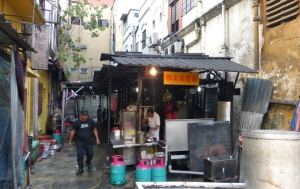 The ethnic Chinese who live in Malaysia have a reputation of being good business people. Here in a laundry, for example, where besides getting your clothes clean, you can buy clean water and use the massage chair, the sign welcomes customers in three languages:
The ethnic Chinese who live in Malaysia have a reputation of being good business people. Here in a laundry, for example, where besides getting your clothes clean, you can buy clean water and use the massage chair, the sign welcomes customers in three languages: 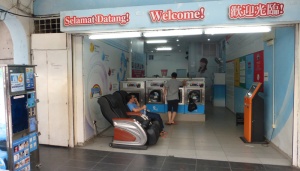
In KL, the main ethnic makeup is 43% Malay, 42% Chinese, and 10% Indian (http://en.wikipedia.org/wiki/Kuala_Lumpur). Although the motto for Malaysia is “Unity is strength,” there is racial tension I was told by a Westerner who has lived in KL; however, Barry and I didn’t see it. In 1965, however, because of racial tensions and violence, Singapore was thrown out of The Federation of Malaysia in part because the KL government was worried about the economic strength of Singapore and its ethnic Chinese majority.
KL too had race riots in 1969. Estimates between 150 to 600 people, mostly ethnic Chinese, died in those KL riots. Since then, many efforts including teaching the Malay language in all schools and promoting the Malay economy help unify this diverse population. Malay’s are given preference in jobs and education (which can’t make the Chinese or Indians who live there happy). The Chinese are good business people, but so too are the Indians, but they usually don’t get the concessions in the modern buildings. For instance, in the Bukit Bintang mega-mall, we could choose from Western, Chinese, Vietnamese, Japanese and other restaurants, but we didn’t see any Indian restaurants.
Also influenced by U.S. news, Barry and I were a bit nervous about Syariah law, the Islamic religious rules. The KL news told of a 30-year-old divorced woman politician who was caught by the religious police in a raid of a hotel at 1:30 a.m. The woman was fully clothed, but the man with her was married and had on only a t-shirt and a towel. The two were charged with “khalwat” (close proximity) with a married man. They face a huge fine, up to three years in prison, or both if found guilty. The story did not give names and was on page five of the newspaper,”The Star.” In the U.S., no arrests would be made, but if something similar were to happen, it would be a front-page story with names and photos in “The National Enquirer.”
Although Barry and I have been married for 26 years, we do have different last names. Would they believe us? And although gambling is not allowed for Muslim citizens, KL has casinos, and we saw a very crowded lottery shop: “Dreams Come True.” 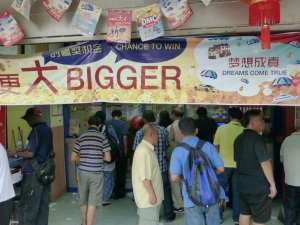 Also Barry took a can of beer with us to the airport where alcohol isn’t offered in the restaurants. As we waited for our flight and ate lunch in the KL food court, Barry held his open beer under the table and took quick sips surreptitiously. A neighboring table was full of Chinese men playing cards, so if the religious police had come, they might have been busy with all of us.
Also Barry took a can of beer with us to the airport where alcohol isn’t offered in the restaurants. As we waited for our flight and ate lunch in the KL food court, Barry held his open beer under the table and took quick sips surreptitiously. A neighboring table was full of Chinese men playing cards, so if the religious police had come, they might have been busy with all of us. 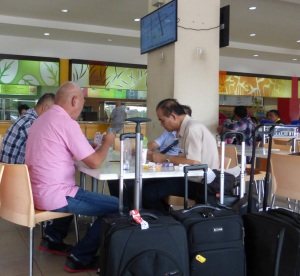 Of course, alcohol, gambling, drugs, . . . such habits are not good for individuals or society overall, but we are used to making our own decisions (and suffering our own personal consequences). Actually, neither Barry nor I saw religious police. I’ve been told that the Malaysian religious police, unlike those in Saudi Arabia, don’t concern themselves with non-Muslims. And the Muslim woman politician caught in the hotel room was probably set up.
Of course, alcohol, gambling, drugs, . . . such habits are not good for individuals or society overall, but we are used to making our own decisions (and suffering our own personal consequences). Actually, neither Barry nor I saw religious police. I’ve been told that the Malaysian religious police, unlike those in Saudi Arabia, don’t concern themselves with non-Muslims. And the Muslim woman politician caught in the hotel room was probably set up.
There is much more I need to learn about this diverse, interesting city–and the country.
Overall, we had a wonderful time and will certainly go back. We haven’t seen some of the most famous KL sites like Petronas Twin Towers, and the beaches and towns outside KL are supposed to be wonderful. Come visit too.
Aloha and sampai jumpa (“see you soon”), Renée


